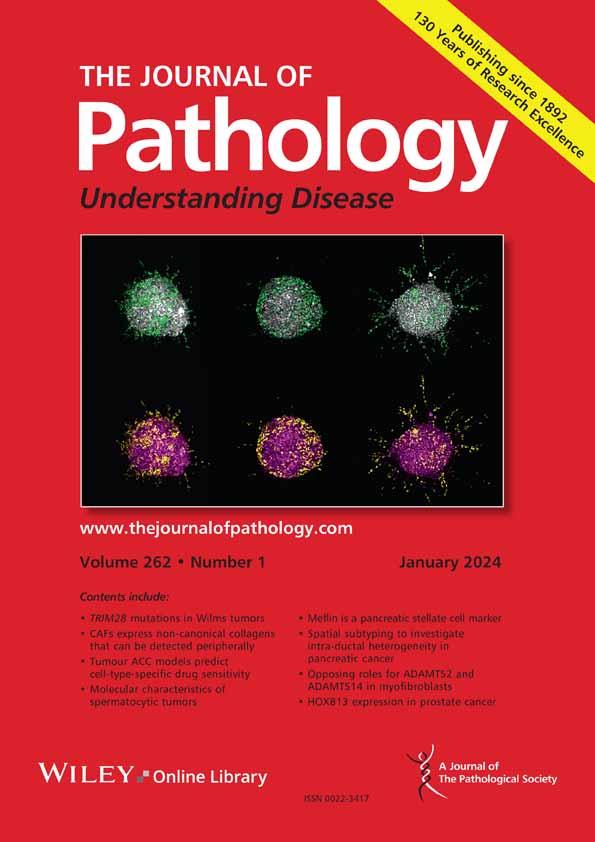Tuan Vo, P Prakrithi, Kahli Jones, Sohye Yoon, Pui Yeng Lam, Yung-Ching Kao, Ning Ma, Samuel X Tan, Xinnan Jin, Chenhao Zhou, Joanna Crawford, Shaun Walters, Ishaan Gupta, Peter H Soyer, Kiarash Khosrotehrani, Mitchell S Stark, Quan Nguyen
下载PDF
{"title":"Assessing spatial sequencing and imaging approaches to capture the molecular and pathological heterogeneity of archived cancer tissues","authors":"Tuan Vo, P Prakrithi, Kahli Jones, Sohye Yoon, Pui Yeng Lam, Yung-Ching Kao, Ning Ma, Samuel X Tan, Xinnan Jin, Chenhao Zhou, Joanna Crawford, Shaun Walters, Ishaan Gupta, Peter H Soyer, Kiarash Khosrotehrani, Mitchell S Stark, Quan Nguyen","doi":"10.1002/path.6383","DOIUrl":null,"url":null,"abstract":"<p>Spatial transcriptomics (ST) offers enormous potential to decipher the biological and pathological heterogeneity in precious archival cancer tissues. Traditionally, these tissues have rarely been used and only examined at a low throughput, most commonly by histopathological staining. ST adds thousands of times as many molecular features to histopathological images, but critical technical issues and limitations require more assessment of how ST performs on fixed archival tissues. In this work, we addressed this in a cancer-heterogeneity pipeline, starting with an exploration of the whole transcriptome by two sequencing-based ST protocols capable of measuring coding and non-coding RNAs. We optimised the two protocols to work with challenging formalin-fixed paraffin-embedded (FFPE) tissues, derived from skin. We then assessed alternative imaging methods, including multiplex RNAScope single-molecule imaging and multiplex protein imaging (CODEX). We evaluated the methods’ performance for tissues stored from 4 to 14 years ago, covering a range of RNA qualities, allowing us to assess variation. In addition to technical performance metrics, we determined the ability of these methods to quantify tumour heterogeneity. We integrated gene expression profiles with pathological information, charting a new molecular landscape on the pathologically defined tissue regions. Together, this work provides important and comprehensive experimental technical perspectives to consider the applications of ST in deciphering the cancer heterogeneity in archived tissues. © 2025 The Author(s). <i>The Journal of Pathology</i> published by John Wiley & Sons Ltd on behalf of The Pathological Society of Great Britain and Ireland.</p>","PeriodicalId":232,"journal":{"name":"The Journal of Pathology","volume":"265 3","pages":"274-288"},"PeriodicalIF":5.2000,"publicationDate":"2025-01-23","publicationTypes":"Journal Article","fieldsOfStudy":null,"isOpenAccess":false,"openAccessPdf":"https://onlinelibrary.wiley.com/doi/epdf/10.1002/path.6383","citationCount":"0","resultStr":null,"platform":"Semanticscholar","paperid":null,"PeriodicalName":"The Journal of Pathology","FirstCategoryId":"3","ListUrlMain":"https://pathsocjournals.onlinelibrary.wiley.com/doi/10.1002/path.6383","RegionNum":2,"RegionCategory":"医学","ArticlePicture":[],"TitleCN":null,"AbstractTextCN":null,"PMCID":null,"EPubDate":"","PubModel":"","JCR":"Q1","JCRName":"ONCOLOGY","Score":null,"Total":0}
引用次数: 0
引用
批量引用
Abstract
Spatial transcriptomics (ST) offers enormous potential to decipher the biological and pathological heterogeneity in precious archival cancer tissues. Traditionally, these tissues have rarely been used and only examined at a low throughput, most commonly by histopathological staining. ST adds thousands of times as many molecular features to histopathological images, but critical technical issues and limitations require more assessment of how ST performs on fixed archival tissues. In this work, we addressed this in a cancer-heterogeneity pipeline, starting with an exploration of the whole transcriptome by two sequencing-based ST protocols capable of measuring coding and non-coding RNAs. We optimised the two protocols to work with challenging formalin-fixed paraffin-embedded (FFPE) tissues, derived from skin. We then assessed alternative imaging methods, including multiplex RNAScope single-molecule imaging and multiplex protein imaging (CODEX). We evaluated the methods’ performance for tissues stored from 4 to 14 years ago, covering a range of RNA qualities, allowing us to assess variation. In addition to technical performance metrics, we determined the ability of these methods to quantify tumour heterogeneity. We integrated gene expression profiles with pathological information, charting a new molecular landscape on the pathologically defined tissue regions. Together, this work provides important and comprehensive experimental technical perspectives to consider the applications of ST in deciphering the cancer heterogeneity in archived tissues. © 2025 The Author(s). The Journal of Pathology published by John Wiley & Sons Ltd on behalf of The Pathological Society of Great Britain and Ireland.
评估空间测序和成像方法,以捕获存档的癌症组织的分子和病理异质性。
空间转录组学(ST)为破译珍贵档案癌症组织的生物学和病理学异质性提供了巨大的潜力。传统上,这些组织很少被使用,只能以低通量进行检查,最常见的是通过组织病理学染色。ST为组织病理学图像增加了数千倍的分子特征,但关键的技术问题和局限性需要更多地评估ST在固定档案组织上的表现。在这项工作中,我们在癌症异质性管道中解决了这个问题,首先通过两种能够测量编码和非编码rna的基于测序的ST协议探索整个转录组。我们对两种方案进行了优化,以处理来自皮肤的福尔马林固定石蜡包埋(FFPE)组织。然后,我们评估了替代成像方法,包括多重RNAScope单分子成像和多重蛋白质成像(CODEX)。我们评估了这些方法在4到14年前储存的组织中的性能,涵盖了一系列RNA质量,使我们能够评估变异。除了技术性能指标外,我们还确定了这些方法量化肿瘤异质性的能力。我们将基因表达谱与病理信息相结合,绘制了病理定义的组织区域的新分子景观。总之,这项工作提供了重要和全面的实验技术视角,以考虑ST在解密存档组织中癌症异质性中的应用。©2025作者。《病理学杂志》由John Wiley & Sons Ltd代表大不列颠和爱尔兰病理学会出版。
本文章由计算机程序翻译,如有差异,请以英文原文为准。






 求助内容:
求助内容: 应助结果提醒方式:
应助结果提醒方式:


